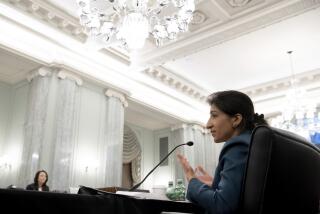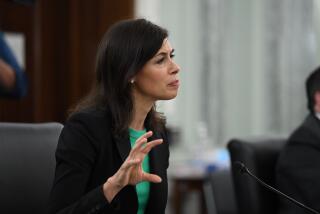Opinion: Chairman Pai’s net neutrality plan: Repeal and maybe replace

Net neutrality regulations are designed to ensure the unfettered flow of online content. (April 26, 2017) (Sign up for our free video newsletter here http://bit.ly/2n6VKPR)
- Share via
If I were writing about net neutrality for the sports section, I’d say that new Federal Communications Commission Chairman Ajit Pai announced Wednesday that he was trading his agency’s net neutrality rules for a player to be named later.
Pai argues that the FCC grossly overreached when it adopted its second set of net neutrality rules in 2015 (the first having been thrown out by an appeals court the year before). Those rules reclassified broadband Internet service providers as utilities, making them subject to strict regulation under Title II of the federal Communications Act.
The point of the reclassification was to allow the FCC to impose a flat ban on ISPs blocking or throttling data from legal sites, services and apps online, and from being paid to prioritize traffic to or from users. That, in a nutshell, is the point of net neutrality rules: to stop ISPs from interfering with their customers’ traffic in a way that distorts competition among the many content and service providers online.
That’s been the status quo online since the dawn of Internet time. But Pai argued that the FCC didn’t need to resort to Title II to preserve it. He proposed to re-reclassify ISPs as information services subject to the “light touch” regulations of yore.
But here’s the problem. As noted above, the Court of Appeals for the D.C. Circuit threw out the net neutrality rules the FCC had adopted in the “light touch” era, saying it didn’t have the power to issue a blanket ban on blocking, throttling or paid prioritization by information services. So how will the agency be able to stop ISPs from interfering with their customers’ traffic and favoring their affiliates’ and partners’ sites over their competitors’?
Based on his speech Wednesday, Pai’s answer to that crucial question is a shrug. “We are seeking comment on how we should approach the so-called bright-line rules adopted in 2015,” Pai said. That suggests he hasn’t worked out a way to protect against the worst potential abuses by ISPs after Title II is taken away.
There’s no shame in that. After all, Pai’s predecessor as chairman, Tom Wheeler, struggled for months to come up with legally defensible net neutrality rules without Title II, and eventually concluded that it couldn’t be done. Pai argues that the decision was political, a cave-in to a meddlesome White House. But before the Obama administration weighed in publicly, Wheeler’s staff had already developed a proposal to reclassify part of a broadband ISP’s service as a Title II utility.
In other words, finding a sure-fire way to protect consumers and the sites and services they use against interference by residential ISPs is tricky without at least some elements of Title II. That’s why the Los Angeles Times’ editorial board has argued repeatedly that Congress needs to update the law to give the FCC clear authority to preserve net neutrality.
(Pai promised to make the text of his notice of proposed rulemaking public Thursday, well in advance of the meeting next month when the commission is expected to vote on whether to issue it. That’s a sharp and welcome break from the commission’s usual practice of keeping such things secret until after the vote.)
Like ISPs and other opponents of tough net neutrality rules, Pai argues that the debate is much ado about nothing. The previous rules not only were unnecessary, he said Wednesday, but were based on “hypothetical harms and hysterical prophecies of doom.”
He must not have been listening when top executives at several leading ISPs argued that they should be allowed to charge sites to deliver their traffic. Instead, he apparently heard only their promises not to do so — promises they made in the hope of dissuading the FCC from regulating them.
At least Pai didn’t endorse two exceptionally bad ideas that had been floating around the agency rumor mill. He made no mention of the proposal to seek voluntary commitments from ISPs not to engage in blocking, throttling or paid prioritization that the Federal Trade Commission would then enforce, a restraint that would be ludicrously easy to circumvent. And he flatly rejected the idea of using a procedural shortcut to rescind the Title II reclassification, saying his proposal would go through the standard rulemaking process of gathering evidence and inviting public comment before being put to a vote, possibly late this year.
Not that the public input is likely to sway Pai. In his remarks Wednesday, he characterized the drive to bring ISPs out from under Title II as “a fight that we are going to win.” But at least he’s giving proponents of the Title II-based approach a chance to build a record to help bolster the lawsuit they will inevitably file against the FCC and Pai for reversing the 2015 rules.
Twitter: @jcahealey
More to Read
A cure for the common opinion
Get thought-provoking perspectives with our weekly newsletter.
You may occasionally receive promotional content from the Los Angeles Times.











